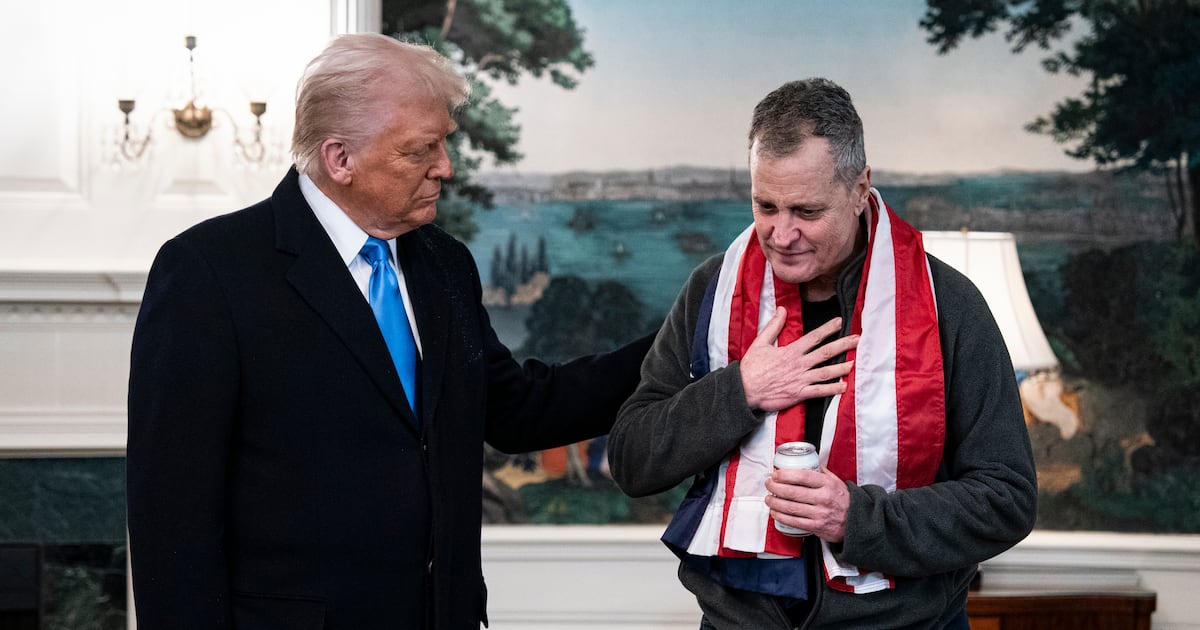MINSK, Belarus—As the countdown ticks off the days and hours before Belarus-Russian war games due to begin Sept. 14, fears are growing here that the Kremlin has some ugly surprises in store.
There are too many open questions: How many Russian units really will be arriving in Belarus? What weapons have been moved in from Russia? And—the big question—what’s Russian President Vladimir Putin’s plan for these troops when, after a week, the exercise is over?
Several independent political observers in Belarus have told The Daily Beast that how many Russian soldiers come to take part in the exercises from Sept. 14 to 20 is less important than how many heavy weapons would remain and be based here permanently. Some analysts worry that Putin is planning to bring the forces from all six Belarusian military training areas and proving grounds toward Ukraine’s border for a violent invasion.
Russia’s motivation for the “strategic” military exercise on the borders with the European Union is to demonstrate to NATO countries Russia’s power and readiness for any confrontation, says a pro-Kremlin expert on security issues, Yuri Krupnov.
“Today we are in life crucial need of Belarus, we need to come out in one single front; later we plan to leave some equipment for [Belarusian President Alexander] Lukashenko to defend Belarus,” Krupnov told The Daily Beast.
Moscow acts as if the Kremlin is preparing for a big war. Russian regional governors are mobilizing forces, and the government is instructing several regions about what they need to produce during “wartime.” At the same time Russia’s military high command deny the “myth” about any plans for invasion.
At a press briefing Deputy Minister of Defense Alexander Fomin complained that the Western press “suggests the most unbelievable scenarios” about Russia’s upcoming invasion of Poland, Lithuania, or Ukraine. “None of these paradoxical versions have anything in common with reality,” Fomin told journalists.
But in the midst of today’s new Cold War not everybody in Belarus is convinced that it is in their country’s interests to aim weapons at their neighbors on the border.
In an exclusive interview with The Daily Beast Belarusian member of parliament Olga Kanopatskaya noted that Moscow’s political agenda has nothing to do with the priority problems Minsk has to solve. “Our country is in great need of reforms,” Kanopatskaya said.
Instead, apparently at Moscow’s urging, Belarus is encroaching on its neighbors.
Earlier this year, Lithuanian Prime Minister Saulius Skvernelis said that the nuclear power plant Belarus is building in Astravyets, only 40 kilometers away from Vilnius, was “a threat” to Lithuania, a member of the European Union and of the North Atlantic Alliance.
“We all realize that Belarus does not really need the nuclear power plant to be constructed on its territory, right on the Lithuanian border, that both the power plant and the military exercises are parts of Moscow’s political plan,” Kanopatskaya noted. Belarus does not have too many enemies. “Let’s be open and honest, our country is not so geopolitically important for any outside enemies or for terrorists to attack us.”
A year ago official reports out of Moscow said that not more than 3,000 Russian soldiers and 280 pieces of equipment would take part in the exercises dubbed Zapad [West] 2017.
But then in November the Russian Ministry of Defense officially ordered 4162 railway wagons to transport its forces to Belarus in September 2017. In July, the Ministry of Defense of Belarus reported that the Zapad exercises would take place on six training fields and proving grounds around Belarus and that 12,700 units would take part in the war games along with 680 items of equipment.
An independent investigation conducted by Russia’s Novaya Gazeta newspaper concluded that the Kremlin was bringing 30 times more Russian soldiers to Belarus than announced. Western media reports said that it looked like Russia was preparing a very significant show to impress NATO generals.
“The key question is what else is there besides the contingent Russia is planning to bring in those 4,162 wagons, and whether Russian soldiers and equipment would remain on our territory,” says Irina Khalip, a Novaya Gazeta journalist based in Minsk. “All we’ve heard so far was lies from Moscow. Our sources tell us that it is going to be 100,000 Russian soldiers participating and not 3,000.”
Since March, Russian paratroopers and ground forces have been arriving to take part in the war games at six Belarusian military bases. NATO’s Supreme Allied Commander Europe, Gen. Philip Breedlove, suggested that the Zapad 2017 military exercise were going to be the biggest Russian war games since the end of the Cold War.
NATO commanders also said they regretted that neither Russia nor Belarus had provided enough transparency for observers. The Belarusian defense ministry said on Aug. 22 that Minsk had invited observers from seven countries: Ukraine, Poland, Lithuania, Latvia, Estonia, Sweden, and Norway, as well as the Organization for Security and Co-operation in Europe (OSCE), but NATO still insisted that Belarusian efforts to provide transparency for the war games “falls short.”
Late last month, Yury Khaschavacki, a well-known Belarusian film maker, was in a hurry to finish editing his new film with a peculiar name: “It’s a Mad, Mad, Mad Russian World.” The film talked about the Russian empire’s historical suppression of Georgian culture and independence. “At this worrisome time, several of Russia’s neighbors, including Georgia, Ukraine, and Belarus feel insecure, as we have seen several times how dangerous Russia’s imperialist ambitions are,” Khaschavacki told The Daily Beast.
“In the worst scenario Russian tanks will invade Ukraine from all directions during the Zapad exercises; in the second worst scenario the Russian military will stay in Belarus, which would mean that Putin took over Lukashenko’s power,” the filmmaker suggested.
In 2014 during the conflict in eastern Ukraine the president of Belarus’ neighbor, Lithuania, called Russia “a terrorist state.” In June this year Lithuania became so concerned about Russian military exercises that the state began to construct a two-meter high wire fence on its border with Russia. “Lithuania along with its NATO allies is ready to withstand any possible threat,” Gintare Narkeviciute, director of International Affairs at Ronald Reagan House in Lithuania, told The Daily Beast. “My concerns about this year’s exercise being a big Kremlin war game is shared by many,’ Narkeviciute said. “I personally have no doubts that as a long-term result Russia will increase its military assets in Belarus and Kaliningrad [a Russian enclave between Lithuania and Poland] and that a number of provocations followed by false information dispersion will happen during the training.”
According to the latest census, a majority of the 10 million people of Belarus identify themselves as Belarusians, rather than Russians. The country’s leader, Alexander Lukashenko, who’s been in power for two decades, did everything to suppress the Belarusian nationalist movement. But recently even Lukashenko has started to praise Belarusian history and culture. The government even considered opening the first university teaching in the Belarusian language, MP Olga Kanopatskaya told The Daily Beast. “The worst tragedy would be if we see civil conflict between pro-Russian and anti-Russian groups in Belarus,” Krupnov said.
Russian independent military expert Alexander Golts explained that in fact, if only Russia had to fight against NATO forces in Europe, stocks full of tanks and other heavy weapons would be needed on the territory of Belarus. “Right now, from what the Russian defense ministry declares, we do not see any huge forces coming to Belarus, but if tomorrow President Vladimir Putin orders snap Inspection, the scale of these exercises will immediately change and that what worries NATO commanders,” Golts said. He noted that on Feb. 26, 2014, President Putin ordered such snap Inspections to mobilize immense Russian military forces on Ukraine’s border.
Presidents Boris Yeltsin and Alexander Lukashenko established what they called the Russian-Belarusian Union State in 1999. But Lukashenko often said that Belarus was a sovereign state, and every June the leader organized spectacular military marches to mark Independence Day.
Then this year, out of the blue, the authoritarian leader decided to open the Belarus border to Europeans and Americans, allowing Western tourists to visit Belarus for five days without a visa. In Moscow it was seen as, “Lukashenko out of control.” Military expert Golts noted that Lukashenko let the Russian defense ministry down, too: “Lukashenko failed his own promise to provide the Baranovichi base for the Russian Air Forces,” Golt said. “He hates to be in the middle of the new Russia-NATO Cold War.”
In the past two decades Belarus has had several financial crises, becoming more and more dependent on Russia economically. Moscow provides Belarus with financial aid and gives Belarus a good price for gas and oil.
Is Putin now, finally, going to take power away from Lukashenko?
“In a way we are already under the Kremlin rule, but by law we are an independent country, and for as long as we have this status quo, Lukashenko will enjoy his power, which he loves to keep,” said MP Kanopatskaya.






